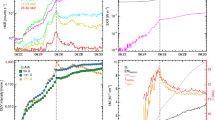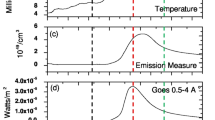Abstract
The hard X-ray time profiles of most solar eruptive events begin with an impulsive phase that may be followed by a late gradual phase. In a recent article (Aurass et al. in Astron. Astrophys. 555, A40, 2013), we analyzed the impulsive phase of the solar eruptive event on November 3, 2003 in radio and X-ray emission. We found evidence of magnetic breakout reconnection using the radio diagnostic of the common effect of the flare current sheet and, at heights of ±0.4 R⊙, of a coronal breakout current sheet (a source site that we called X).
In this article we investigate the radio emission during the late gradual phase of this event. The work is based on 40 – 400 MHz dynamic spectra (Radio Spectrograph, Observatorium Tremsdorf, Leibniz Institut für Astrophysik Potsdam, AIP) combined with radio images obtained by the French Nançay Multifrequency Radio Heliograph (NRH) of the Observatoire de Paris-Meudon. Additionally, we use Ramaty High Energy Solar Spectroscopic Imager (RHESSI) hard X-ray (HXR) flux records, and Solar and Heliospheric Observatory (SOHO) Large Angle and Spectrometric Coronagraph (LASCO) and Extreme ultraviolet Imaging Telescope (EIT) images.
The analysis shows that the late gradual phase is subdivided into two distinct stages. Stage 1 (lasting five minutes in this case) is restricted to reoccurring radio emission at source site X. We observe plasma emission and an azimuthally moving source (from X toward the NE; speed≈1200 km s−1) at levels radially ordered against the undisturbed coronal density gradient. These radio sources mark the lower boundary of an overdense region with a huge azimuthal extent. By the end of its motion, the source decays and reappears at point X. This is the onset of stage 2 traced here during its first 13 minutes. By this time, NRH sources observed at frequencies≤236.6 MHz radially lift off with a speed of ≈ 400 km s−1 (one third of the front speed of the coronal mass ejection (CME)) as one slowly decaying broadband source. This speed is still observable in SOHO/LASCO C3 difference frames in the wake of the CME four hours later. In stage 2, the radio sources at higher frequencies appear directly above the active region with growing intensity.
We interpret the observations as the transit of the lower boundary of the CME body through the height range of the coronal breakout current sheet. The relaxing global coronal field reconnects with the magnetic surroundings of the current sheets that still connect the CME in its wake with the Sun. The accelerated particles locally excite plasma emission, but can also escape toward the active region, the CME, and the large-scale solar magnetic field. The breakout relaxation process may be a source of reconnection- and acceleration rate modulations.
In this view, the late gradual phase is a certain stage of the coronal breakout relaxation after the release of the CME. This article is, to our best knowledge, the first observational report of the coronal breakout recovery. Our interpretation of the radio observations agrees with some predictions of magnetic breakout simulations (e.g. Lynch et al. in Astrophys. J. 683, 1192, 2008). Again, combined spectral and imaging radio observations give a unique access to dynamic coronal processes that are invisible in other spectral ranges.










Similar content being viewed by others
References
Antiochos, S.K., DeVore, C.R., Klimchuk, J.A.: 1999, Astrophys. J. 510, 485.
Aurass, H., Landini, F., Poletto, G.: 2009, Astron. Astrophys. 506, 901.
Aurass, H., Rausche, G., Mann, G.: 2007, Astron. Astrophys. 471, L37.
Aurass, H., Mann, G., Zlobec, P., Karlický, M.: 2011, Astrophys. J. 730, 57.
Aurass, H., Holman, G., Braune, S., Mann, G., Zlobec, P.: 2013, Astron. Astrophys. 555, A40 (P1).
Bastian, T.S., Pick, M., Kerdraon, A., Maia, D., Vourlidas, A.: 2001, Astrophys. J. 558, L65.
Ciaravella, A., Raymond, J.C.: 2008, Astrophys. J. 686, 1372.
Dauphin, C., Vilmer, N., Krucker, S.: 2006, Astron. Astrophys. 455, 339.
Dauphin, C., Vilmer, N., Lüthi, T., Trottet, G., Krucker, S., Magun, A.: 2005, Adv. Space Res. 35, 1805.
Démoulin, P., Hénoux, J.C., Priest, E.R., Mandrini, C.H.: 1996, Astron. Astrophys. 308, 643.
Grayson, J.A., Krucker, S., Lin, R.P.: 2009, Astrophys. J. 707, 1588.
Holman, G.D.: 2012, Phys. Today 65(4), 56.
Holman, G.D., Aschwanden, M.J., Aurass, H., Battaglia, M., Grigis, P.C., Kontar, E.P., et al.: 2011, Space Sci. Rev. 159, 107.
Karpen, J.T., Antiochos, S.K., DeVore, C.R.: 2012, Astrophys. J. 760, 81.
Kerdraon, A., Delouis, J.M.: 1997, In: Trottet, G. (ed.) Coronal Physics from Radio and Space Observations, Lecture Notes Phys. 483, Springer, Berlin, 192.
Kiplinger, A.L.: 1995, Astrophys. J. 453, 973.
Ko, Y.-K., Raymond, J.C., Lin, J., Lawrence, G., Li, J., Fludra, A.: 2003, Astrophys. J. 594, 1068.
Lynch, B.J., Antiochos, S.K., MacNeice, P.J., Zurbuchen, T.H., Fisk, L.A.: 2004, Astrophys. J. 617, 589.
Lynch, B.J., Antiochos, S.K., DeVore, C.R., Luhmann, J.G., Zurbuchen, T.H.: 2008, Astrophys. J. 683, 1192.
MacNeice, P., Antiochos, S.K., Phillips, A., Spicer, D.S., DeVore, C.R., Olson, K.: 2004, Astrophys. J. 614, 1028.
Maia, D.J.F., Gama, R., Mercier, C., Pick, M., Kerdraon, A., Karlický, M.: 2007, Astrophys. J. 660, 874.
Mann, G., Baumgärtel, K., Chernov, G.P., Karlický, M.: 1989, Solar Phys. 120, 383.
Mann, G., Klassen, A., Aurass, H., Classen, H.-T.: 2003, Astron. Astrophys. 400, 329.
Melrose, D.B.: 1985, In: McLean, D.J., Labrum, N.R. (eds.) Solar Radiophysics, Cambridge University Press, Cambridge.
Newkirk, G.A.: 1961, Astrophys. J. 59, 61.
Rausche, G., Aurass, H., Mann, G., Karlický, M., Vocks, C.: 2007, Solar Phys. 245, 327.
Somov, B.V.: 1986, Astron. Astrophys. 163, 210.
Somov, B.V.: 2000, Cosmic Plasma Physics, Astrophys. Space Sci. Library 251, Kluwer Academic Publ., Boston.
Vourlidas, A., Syntelis, P., Tsinganos, K.: 2012, Solar Phys. 280, 509.
Vršnak, B., Warmuth, A., Temmer, M., Veronig, A., Magdalenic, J., Hillaris, A., Karlický, M.: 2006, Astron. Astrophys. 448, 739.
Warmuth, A., Holman, G.D., Dennis, B.R., Mann, G., Aurass, H., Milligan, R.O.: 2009, Astrophys. J. 699, 917.
Webb, D.F., Burkepile, J., Forbes, T.G., Riley, P.: 2003, J. Geophys. Res. 108(A12), 1440.
Acknowledgements
The author is grateful to the Leibniz-Institut für Astrophysik Potsdam (AIP) for the guest status. He thanks his former colleagues at AIP, especially G. Mann. Furthermore, he acknowledges the open data policy of the French Nançay Multifrequency Radio Heliograph of the Observatoire de Paris (CNRS), and especially the support by A. Kerdraon in discussing some data processing issues. In this work GOES, RHESSI, and SOHO data were used. The author is obliged to the teams managing these data sources. The coronagraph and ultraviolet difference images are obtained from the CDAW Data Center at Goddard Space Flight Center, which is supported by NASA’s Living with a Star program and the SOHO project. The author gratefully acknowledges the constructive comments of an anonymous referee.
Author information
Authors and Affiliations
Corresponding author
Rights and permissions
About this article
Cite this article
Aurass, H. The Late Gradual Phase of Large Flares: The Case of November 3, 2003. Sol Phys 289, 4517–4531 (2014). https://doi.org/10.1007/s11207-014-0604-9
Received:
Accepted:
Published:
Issue Date:
DOI: https://doi.org/10.1007/s11207-014-0604-9




